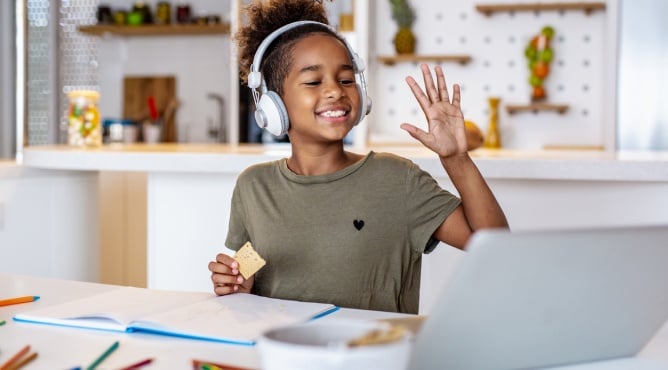Outschool has noticed that families will often search for and enroll in a class based on a previous good experience with the educator. Obviously, a learner’s experience in your class is based on a multitude of factors, but one way to make sure you leave an impression is to take the time to personally connect with your learners. Follow these tips to build long-lasting, impactful relationships that inspire future enrollments and great class reviews.
1. Make Time to Connect
Set aside time in each class to get to know your learners. Spend the first 3-5 minutes playing a name game where learners share something about themselves (i.e. “My name is Maria and I like mac ‘n cheese!”), or use the end of class as an open share time for learners to talk about their day or week. While these activities may not include teaching on your class topic, your classroom community benefits from the opportunity to connect with you and one another. When learners have a sense of belonging and feel welcomed into the learning space, they are more likely to remain engaged in the lesson and be responsive to behavior management strategies. Building this time into your lesson plans will ensure that forming these relationships remains a priority and connections grow over time.
Check out this resource for icebreaker and name-game ideas!
2. Find Common Ground
As you’re getting to know your learners, look for common interests that can pave the way for great conversations or even influence your curriculum design. Do you have a 1:1 math class with a learner who loves sci-fi movies as much as you do? Write a few story problems about your favorite characters! Or maybe you found out you have a classroom of kids who connect over a love of soccer – could you frame your Spanish lesson around the sport? Use mutual interests to “bring the fun” to class and add that personal touch to your instruction.
3. Use Private Learner Notes to Guide Instruction
If you teach multiple classes or are generating a lot of new sign-ups, it can be difficult to remember the personal learner details that will help you build a strong relationship with each individual. Private learner notes (located under the Learners tab in your classroom) are a great way to keep track of important information and allow you to create lesson plans based on individual needs. Does Ariana do better with written, instead of verbal, instructions? Is Jose worried about his pet cat and could use a pick-me-up game in class? Did Taylor respond well to a certain behavior management technique? Tracking these learner traits will help you ensure that you’re delivering the best possible instruction and can make your class stand out from the crowd.
4. Consider Learner Backgrounds
Outschool is a global community, consisting of learners, families, and educators with a wide variety of backgrounds and life experiences. In order to reach every learner, it’s important to become familiar with inclusive, anti-bias teaching practices and prioritize introducing them to your classroom. If you’re new to anti-bias education or are looking to hone your skills, these articles from the Educator Library are a great place to start:
- Creating lesson plans for an inclusive classroom
- Creating a class on your lived experience
- Support learner agency
You can also check out this post to help you create inclusive lesson plans. By implementing these strategies, you let learners know that you care about where they’re coming from, who they are, and what experiences they’re bringing into your classroom.
5. Use Multiple Channels to Communicate
With Outschool’s @mentions feature, educators and learners can communicate with each other through the Outschool classroom. When a learner is tagged with an @mention in a thread, they’ll receive an email notifying them that they have a message waiting. Use this feature to bring individual learners into the conversation and stay engaged throughout the week. Post group questions (either related to your class topic or just for fun), then reply to each response with a mention to encourage participation. Or respond to learner questions with @mentions to ensure learners see your comments and feel heard. For more about how to use classroom conversations and @mentions, check out this post.
As an educator, you have the opportunity to truly make a difference in the lives of your learners – and that starts with gaining their trust and building rapport. We hope these tips will help you form bonds with your learners, connect with families, and inspire continued enrollment.

